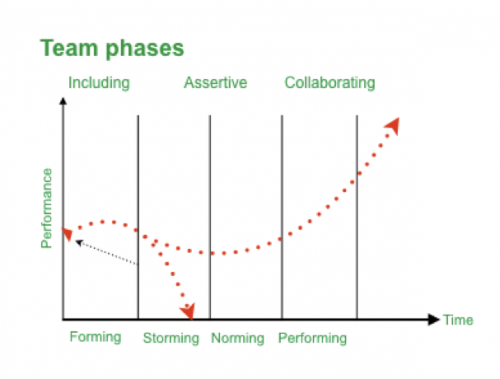
Last week, we took a deeper dive into understanding how the mental states of each team member has an influence on the whole team – and that the team leader probably has more influence on this than anybody else. If you did not read that post, you might want to start there first.
The mental state that team members are in also produces a certain collective behaviour, especially as there are states that are typical for each stage of the life cycle of a team.
When we put a bunch of people together in a team, they typically go though certain stages. This was first described by Psychologist Bruce Tuckman who came up with the memorable phrase “forming, storming, norming, and performing” in his 1965 article, “Developmental Sequence in Small Groups.”

So this is not new. On the contrary, it is well established framework and many of you have probably heard the expression “forming, storming, norming and performing” before. The words that describe the basic stages that small groups experience. In theory, this is a linear process that starts with forming and then goes step by step through all four stages. But the challenge in this is that most teams do not naturally follow this path – they need some help or else they get stuck.
What stage is your team at?
So what is important is for the team leader to recognise the stages as they unfold in the team and to act skilfully in helping the team through each stage. Part of this team leader’s awareness also means understanding that the team is basically an unstable system, and that from time to time it will regress from the current stage and take a step or even two steps back to previous stages. And it requires skillful action on the part of the team leader to get the team back on track.
Less experienced team leaders often have an aversion to conflict. They feel it is all important that we all get along and have a nice time. So when the initial phase, the forming stage, is coming to an end and the first signs of friction become apparent, the typical reaction is to reorganise the team in order to stop the conflict from escalating. The deep fear is that this could get really ugly.
The quick fix is to shuffle positions or tasks, maybe even transferring one or more team members away from the team to other teams or whatever. The shuffle causes the team process to reset and a new period of forming starts. And it creates the illusion that the conflict or problem is solved.
During the forming stage, everyone is doing their best to fit in and not rock the boat too much. They are also trying their best to adapt to everyone else. But after a while, the friction invariably starts again. It happens because after a while, each of the team members have had enough, they are tired of not voicing their need and constantly trying to bend over backwards to keep everyone happy and they start to voice their dissatisfaction.
Conflict is just a symptom.
Friction is not a bad thing as such; it is just a symptom that we need to align whatever we are doing better with each other.
The way we do that is that we start a number of conversations about how the team is functioning and what we need to do in order for everything to work better for all. This may mean some heated meetings and possible disharmony, but eventually the skillful team leader will help the team come to an understanding that enables them to move forward – typically by establishing some rules of engagement or a team manifesto. As they do, the team moves out of the storming into the norming stage and after a while it becomes (high) performing.
You need to work on the fluffy stuff.
As the team leader, it is important for you to understand that it is hard to get to any level of (high) performance without investing time and energy in what is often seen as the fluffy stuff. You need to have the necessary conversations; conversations that aim on developing better relations and not just on task accomplishments. Handling this in a helpful way that keeps everyone on the bus and heading in the same direction is not something we are born with – it is learned skill.
In my next online training, the Team Leader’s Toolbox, I will go into much more detail on how to actually do this in practical terms. Because it is not rocket science, it just requires you to be aware of some basic principles about human behaviour and the importance of relationships.
 Enter your email address below and we will notify you when we launch the Team Leader’s Toolbox!
Enter your email address below and we will notify you when we launch the Team Leader’s Toolbox!
___________________________________________________________
This post is one of a series where we are exploring the notion of leadership and how this is different from management. Our starting point is the Service Profit Chain and the understating that the management part of our job will only take us so far. If we really want to create an organisation that is capable of delivering outstanding customer experiences, we need to develop an organisation that delivers outstanding employee experiences – and that requires leadership. You can check out other articles of the series below:
- Are you an inspiring leader to work for?
- What does it require to be an inspirational leader?
- The something for something system is at the heart of the uninspiring workplace.
- How is team management different from team leadership and why should I worry?
- Teams are organic systems, and therefore, by definition unstable.
- How you can help you team manage their states
[…] blog posts, I have explain this concept of states and stages in more details, you may want to read this […]